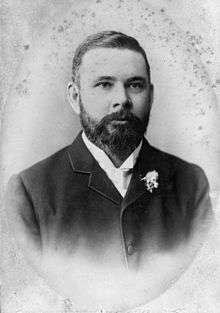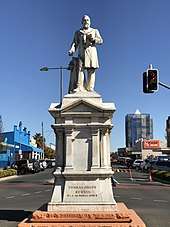Thomas Joseph Byrnes
| The Honourable Thomas Joseph Byrnes | |
|---|---|
 | |
| 12th Premier of Queensland | |
|
In office 13 April 1898 – 27 September 1898 | |
| Preceded by | Sir Hugh Nelson |
| Succeeded by | James Dickson |
| Constituency | Warwick |
| Member of the Queensland Legislative Assembly for Cairns | |
|
In office 29 April 1893 – 4 April 1896 | |
| Preceded by | Frederick Wimble |
| Succeeded by | Isidor Lissner |
| Member of the Queensland Legislative Assembly for Warwick | |
|
In office 4 April 1896 – 27 September 1898 | |
| Preceded by | Arthur Morgan |
| Succeeded by | Arthur Morgan |
| Member of the Queensland Legislative Council | |
|
In office 12 August 1890 – 13 March 1893 | |
| Personal details | |
| Born |
11 November 1860 Spring Hill, Queensland |
| Died |
27 September 1898 (aged 37) Brisbane, Queensland |
| Resting place | Toowong Cemetery |
| Nationality | Australian |
| Political party | Ministerialist |
| Alma mater | University of Melbourne |
| Occupation | Barrister |
Thomas Joseph Byrnes (11 November 1860 – 27 September 1898) was Premier of Queensland from April 1898 until his death in October of the same year, having previously served in several ministerial positions in his parliamentary career.[1] He was the first Roman Catholic Premier of Queensland and the first to die in office.
Early life
Byrnes was born in Spring Hill, Queensland, to Irish immigrants Patrick Byrnes and his wife Anna, née Tighe.[1] Byrnes was educated at Bowen State School, then, winning a scholarship where he topped the state,[2] he studied at Brisbane Grammar School and then studied arts and law at the University of Melbourne, graduating with honours in both. During his time at the University of Melbourne he was Prelector of the Dialectic Society of Trinity College (University of Melbourne),[3] winning the Society's inaugural Wigram Allen Prize in 1883, only months after it had been established by Sir George Wigram Allen.[4] In 1882-83 Byrnes taught at Xavier College.[1]
Career
Byrnes was admitted as a barrister in Victoria on 8 July 1884 and returned for a Queensland admission on 5 August; he then began a successful career as a barrister.[1] Byrnes' talent brought him to the attention of fellow barrister Sir Samuel Griffith, then Premier of Queensland, who had him appointed Solicitor-General with a seat in the Legislative Council. Byrnes stood down from the Legislative Council to successfully stand for Cairns in the Legislative Assembly in 1893. He represented Cairns until 1896, after which he represented Warwick in the Legislative Assembly from 1896 to his death in 1898.[5]
Byrnes continued his private law practice and participated in two major Supreme Court of Queensland cases. In the Queensland Investment Co. v. Grimley case, Byrnes successful conduct of the defence was praised widely. In the John Robb arbitration case of 1892, praise for Byrnes skill was accompanied by public objection to the high fees paid to Samuel Griffith as leading counsel and to Byrnes as one of his assistants.[1] In 1895 and 1897, Byrnes represented Queensland at meetings of the Federal Council of Australasia.[1]
Sir Thomas McIlwraith appointed him as Attorney-General of Queensland in the Continuous Ministry, and when Hugh Nelson stepped down as Premier; Byrnes, the youngest member of the Ministry by a large margin, became Premier.


Late life
Byrnes' ability had led many to expect great things of him, but he contracted measles then pneumonia and died on 27 September 1898. Byrnes was accorded a state funeral which proceeded from St Stephen's Cathedral to the Toowong Cemetery.[6]
Legacy
Byrnes is commemorated by two statues, one in Centenary Place in Brisbane and the heritage-listed T J Byrnes Monument in Warwick, both funded by public subscriptions.[1]
The commissioning of the Brisbane statue encountered a series of setbacks. The sculptor Achille Simonetti originally approached by the committee to create the statue had never seen Byrnes during his life and produced a plaster cast from photographs for the committee's approval before commencing the statue. The committee did not think the cast was sufficiently like Byrnes and there were a number of iterations before they were satisfied.[7][8] Then there was an argument of whether Byrnes should be depicted in a university gown or in an ordinary frock coat, deciding on a frock coat in order to depict Byrnes as the premier rather than as a lawyer.[9] Then as Simonetti was tendering to provide a 9-foot-tall bronze statue for £1,800, a local sculptor James Laurence Watts offered to provide the statue for only £1,000, dividing the committee.[10][11] However, after Byrnes' sisters indicated their strong preference for Simonetti's work and Simonetti offered a revised tender of £1400, the committee went ahead and commissioned the statue from Simonetti.[12] Early in 1900, the argument about the clothing erupted once more when Simonetti expressed an artistic preference for robes rather than a frock coat, and the committee reversed its decision in favour of robes.[13] During this argument, Simonetti took ill and died. It was then announced in the newspaper that it had been Simonetti's wish that his former pupil, James White, should complete his unfinished commissions.[14] The committee negotiated with White,[15] but finally gave the commission to sculptor Bertram Mackennal.[16]
The township of Byrnestown in Queensland is named after him, as is its main street Byrnes Parade and its railway station.[17]
References
- Byrnes, Thomas Joseph — Brisbane City Council Grave Location Search
- 1 2 3 4 5 6 7 Rosemary Howard Gill, 'Byrnes, Thomas Joseph (1860 - 1898)', Australian Dictionary of Biography, Vol. 7, Melbourne University Press, 1979, pp 517-519. Retrieved 19 April 2010
- ↑ Serle, Percival (1949). "Byrnes, Thomas Joseph". Dictionary of Australian Biography. Sydney: Angus and Robertson. Retrieved 19 April 2010.
- ↑ "DEATH OF THE QUEENSLAND PREMIER". The Advertiser. Adelaide. 27 September 1898. p. 10. Retrieved 25 August 2016 – via National Library of Australia.
- ↑ "NEWS OF THE DAY". The Age (8924). Victoria. 24 September 1883. p. 4. Retrieved 25 August 2016 – via National Library of Australia.
- ↑ "Alphabetical Register of Members of the Legislative Assembly 1860-2012 and of the Legislative Council 1860-1922" (PDF). Queensland Parliamentary Record 2009–2012: The 53rd Parliament. Queensland Government. Retrieved 2 August 2013.
- ↑ "Classified Advertising". The Brisbane Courier. 29 September 1898. p. 8. Retrieved 28 January 2016 – via National Library of Australia.
- ↑ "THE SUGAR INDUSTRY". The Queenslander. LVI (1236). 15 July 1899. p. 141 (Unknown). Retrieved 22 January 2017 – via National Library of Australia.
- ↑ "THE MINISTER FOR AGRICULTURE SPEAKS OUT". The Brisbane Courier. LVI (12, 955). 20 July 1899. p. 4. Retrieved 22 January 2017 – via National Library of Australia.
- ↑ "THE BYRNES MEMORIAL". Queensland Times, Ipswich Herald and General Advertiser. XL (5986). 18 November 1899. p. 4. Retrieved 22 January 2017 – via National Library of Australia.
- ↑ "QUEENSLAND". The Age (13, 960). Victoria. 30 November 1899. p. 6. Retrieved 22 January 2017 – via National Library of Australia.
- ↑ "QUEENSLAND". The Catholic Press. III (214). New South Wales. 9 December 1899. p. 9. Retrieved 22 January 2017 – via National Library of Australia. Download
- ↑ "THE BYRNES MEMORIAL". Queensland Times, Ipswich Herald and General Advertiser. XL (5997). 14 December 1899. p. 4. Retrieved 22 January 2017 – via National Library of Australia.
- ↑ "THE BYRNES MEMORIAL COMMITTEE". The Brisbane Courier. LVI (13, 157). 14 March 1900. p. 5. Retrieved 22 January 2017 – via National Library of Australia.
- ↑ "THE SYDNEY MORNING HERALD". The Sydney Morning Herald (19, 359). 30 March 1900. p. 5. Retrieved 22 January 2017 – via National Library of Australia.
- ↑ "BYRNES MEMORIAL FUND". The Brisbane Courier. LVI (13, 204). 8 May 1900. p. 6. Retrieved 22 January 2017 – via National Library of Australia.
- ↑ "The Byrnes Monument in Brisbane". The W.A. Record. XXVII (1147). Western Australia. 20 September 1902. p. 18. Retrieved 22 January 2017 – via National Library of Australia.
- ↑ "Byrnestown (entry 45325)". Queensland Place Names. Queensland Government. Retrieved 3 August 2013.
External links
| Wikimedia Commons has media related to Thomas Joseph Byrnes. |
| Political offices | ||
|---|---|---|
| Preceded by Sir Hugh Nelson |
Premier of Queensland 13 April – 27 September 1898 |
Succeeded by James Dickson |
| Parliament of Queensland | ||
| Preceded by Frederick Wimble |
Member for Cairns 1893–1896 |
Succeeded by Isidor Lissner |
| Preceded by Arthur Morgan |
Member for Warwick 1896–1898 |
Succeeded by Arthur Morgan |